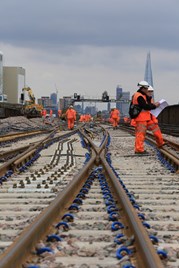 Read the peer reviews for this feature.
Read the peer reviews for this feature.
Download the graphs for this feature.
Britain’s track owner is a nationalised company. It has been since Network Rail took over from Railtrack in 2002.
Between then and the reclassification of NR’s debts onto government’s books last year, the pretence was maintained that NR was a private company. Now it is beyond doubt that it is nationalised, with its chairman answering directly to the Secretary of State for Transport.
And there have been many questions to answer, chiefly surrounding the state of the company’s enhancements programme. While day-to-day running has presented few major problems and little comment, NR’s upgrade work has attracted plenty of critical headlines. London Bridge station’s remodelling has not gone well, with chaotic scenes of crowds of delayed passengers. Electrification projects are running late - and over-budget. And there is continuing uncertainty about signalling upgrades.
The situation inevitably leads to calls for “something to be done”. In examining what exactly could be done, attention should be paid to both the problem and potential answers. The problem could be structural: Is an overarching single company responsible for all aspects of rail infrastructure, its operation, maintenance, renewals and enhancements the optimal solution? Should the company be split by function? Or by geography? Or in some other way?
If it’s not considered to be a structural problem, is it then a problem of skills and performance? Or volume of work?
Many of the structural challenges were closely examined during the Conservative government’s privatisation planning work in the early 1990s. There was plenty of tension between the Department of Transport (DTp) and the British Railways Board (BRB) in that period. The Treasury was also closely and inevitably involved, with one eye on the money and the other on its usual ambition to control all government departments.
The DTp built four options: Unitary privatisation of BR complete; by business sector (InterCity, Network SouthEast, Regional Railways and Freight); by Region; and by a combination of track authority and train operators. The BRB was pushing a fifth option… that of a National Rail Authority that would contract out services such as engineering, and franchise or sell lines and routes. It would have a holding company to own the track, and make strategic decisions.
Railtrack and Network Rail
Government opted for the track authority and train operator option, by creating Railtrack and selling franchises to private operators. Fast forward two decades and with Railtrack having been sold and gone bust, and its successor (Network Rail) now being owned by government, it can be argued that NR is the National Rail Authority, albeit with some of the grand strategic functions held by its parent, the Department for Transport.
Railtrack was created on a central board plus regional fiefdom basis, in a mirror of the BR structure before sectorisation. It contracted out most of its services, so that private companies provided the bulk of its maintenance and renewals work.
That structure remains today. Railtrack named its geographic areas ‘Zones’ (which differentiated from the Regions that BR had used). NR has ‘Routes’ that remain geographic and broadly match what has gone before.
Overlaid is a national ‘Infrastructure Projects’ (IP) group that is charged with delivering enhancements and renewals, leaving the Routes to concentrate on operating and maintaining the railway (maintenance having been brought in-house, whereas Railtrack had let it to contractors).
This leaves the Route Managing Director (RMD) responsible for running the railway on his patch, but not responsible for the major work that has so often prevented the railway from running. Over-running engineering work - a plague on Monday mornings, and making the headlines last Christmas at King’s Cross and Paddington - remains a major culprit for the railway not being available to passengers.











